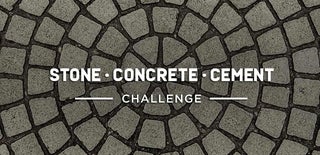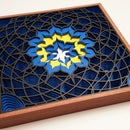Introduction: Concrete Phone Stands, 3D-Printed Mold
This is the 3rd version of the concrete phone stand.
The previous version involved a PVC pipe, wood inserts, and complex cuts into a PVC pipe. The first version used a Tupperware box.
The quality of the concrete surface is always directly dependent on the mold surface.
This version still involves a PVC pipe, and uses 3D-printed inserts, enabling easy production of molds, for example for workshops. It has a swappable logo plate.
With a mold, one phone stand can be produced in ca. one noon break, at your office!
Step 1: Mold Concept
The mold consists of the following pieces:
- PVC pipe for the outer shell.
- Skewed plate, forming the plane on which the phone will rest.
A small piece is attached with a screw, to close the "nose". - Cavity mold, creating the cable cavity, and cable roll storage. It has arms to form a cross, in order to make a precise positioning into the PVC tube.
A closing lid adds rigidity, and is inserted into a grove of the cavity mold. When the lid is removed, the cavity shape can be squeezed for easier demolding.
Step 2: Make the Parts
3D printed parts:
Print each of the 4 STL files embedded in this step. They match a PVC pipe with 10 cm inner diameter.
- 1-top.stl -- skewed plat
- 2-top-rest.stl -- to be attached to 1, using a screw
- 3-top-label.stl -- logo to be snapped into 1
- 4-bottom.stl -- cavity mold, with its lid
For source files in OpenSCAD format, see my GitHup repository.
PVC pipe:
Take a PVC pipe of 10 cm inner diameter, and cut it to a height of precisely 13.5 cm.
Carefully make a vertical cut, to ease later demolding.
Step 3: Gathering Parts for a Kit
Kit:
Able to fit in one box:
- A soup spoon, for concrete powder
- A spatula, to mix the concrete
- A brush, to apply grease
- A rubber bowl, to mix the concrete
- A bowl for water
- A small jar of grease
- A small jar of concrete sealant
- Masking tape
Concrete:
Another box with fine (sieved, if needed) concrete.
Additionally you can use concrete pigment in powder form, to give it a desired tint.
Step 4: Assembling the Parts
- Tape the PVC pipe.
- Apply the logo inside the top part (skewed plate). Mind the orientation!
- Fit the top part into the pipe. Note: the mold is upside-down, so the top part is now at the bottom.
Step 5: Applying Grease
- Apply grease on the inner side of the PVC Tube and on the inner side of the skewed plate.
ADVICE: To make what will become the top edge less sharp and breakable, fill the bottom with some grease, and carefully spread to form a nicely rounded fillet. - Assemble the two parts of the cavity mold together, and liberally spread grease on its surface.
- Position the cavity mold on the PVC pipe. Carefully align it to the "nose" of the skewed plate.
- Tape the cavity mold to the PVC pipe.
Step 6: Mixing and Pouring the Concrete
- Pour concrete into the rubber bowl, and progressively add water while mixing. Not the other way round!
- Obtain a smooth and creamy mixture.
- Pour into the mold. The concrete surface should just not touch the arms of the mold.
- Shake/vibrate to remove bubbles.
Step 7: Waiting...
After 3 to 4 days, check if the concrete is cured and dry. But to be absolutely safe, wait one week.
Step 8: Demolding and Priming
- Carefully demold.
- Rectify edges and bottom side with sand paper (wet). Let dry.
- Apply concrete sealant to glue the sand grains together and keep the surface smooth while aging.
Step 9: Optional: Make a Protective Pad
This optional step will ensure protection of the surfaces, and avoid wiggling.
- Wet-sand the bottom side of the stand.
- Cut out a protective pad in a 3-5 mm thick MDF sheet, and glue it on the bottom.
SVG file for laser cutting will be added here.
Step 10: Finished Product
This is the finished product.
You can optionally spray-paint it, or leave it natural.
For the one on the photo, a fair amount of pigments for concrete was added in step 6.
Love it? or still unsatisfied with the results? Make more!

Participated in the
Stone, Concrete, Cement Challenge

















